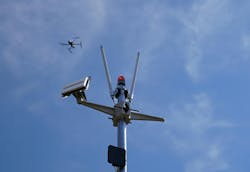BRINC and Echodyne team to enable automated BVLOS without observers for first responder UAVs
SEATTLE - BRINC, a Seattle-based company specializing in uncrewed aerial vehicle (UAV) technology for first responders, announced it is partnering with ground-based radar systems company Echodyne in Kirkland, Wash. to integrate Echodyne's advanced MESA radar technology into BRINC's purpose-built Drone as First Responder (DFR) solution. The strategic relationship enables a path toward beyond-visual line of sight (BVLOS) operations without visual observers, advanced airspace awareness for safer operations, and lowers the barrier to entry for public safety agencies looking to start or expand DFR programs.
Drone as First Responder (DFR) systems are designed to reduce emergency response times and enhance decision-making for first responders. However, current Federal Aviation Administration (FAA) regulations require a visual observer to be onsite for drone operations, which limits the flexibility and operating hours of these systems. This requirement also adds to the staffing challenges faced by public safety agencies across the United States. A 2023 study by the Police Executive Research Forum highlighted these challenges, showing a rise in police resignations over the past four years, along with a 5% decrease in the number of sworn officers.
DFR systems need to operate over extended ranges and in environments with obstructions or adverse weather. To achieve this, Beyond Visual Line of Sight (BVLOS) waivers are crucial. A new partnership between BRINC and Echodyne aims to enhance the safety and reliability of these operations, offering a pathway for BRINC's customers to meet FAA requirements for BVLOS without needing a visual observer.
Related: BRINC announces LiveOps drone platform for first responders
Echodyne's radar systems provide continuous monitoring and real-time data on the drone's surroundings, including other aircraft, obstacles, and sudden changes in the environment.
"Echodyne radars have been used for years by UAS centers of excellence, as well as FAA and NASA testing programs," said Eben Frankenberg, Echodyne CEO. "DFR represents a unique opportunity to introduce widescale BVLOS operations, and radars are the ideal sensor to provide detailed and accurate airspace situational awareness."
BRINC's DFR system integrates Echodyne's radar technology, sending radar data to an agency's LiveOps account. This integration allows agencies to monitor drone operations alongside ADS-B data, airspace advisories, weather conditions, and radar readings. The system also enables automated safety measures, such as alerting pilots to potential dangers or grounding and rerouting drones to avoid air traffic.
